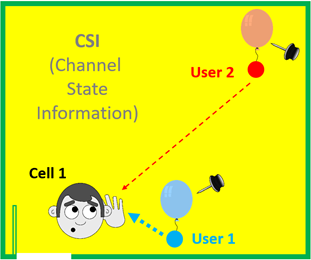
Download Notes
Channel State Information (CSI) - Analogy.pptx (65.0 KB)
Channel State Information (CSI) - Analogy.xlsb (27.6 KB)
Slide Notes
When the frequency spectrum is limited, we need to look for alternatives that increase its efficiency.
Several techniques are used for this improvement, but to do so, they need to know the properties of the channel used in the communication.
But how is it possible to know this information?
Let’s see this concept now, through an analogy that will make us understand how and why it is necessary to know the channel’s properties.
Imagine a room - completely dark - with two people, one near the entrance door (User 1) and one at the back of the room (User 2).
Imagine a third person also near the entrance door (Let’s call it Cell 1)
Now think about it and answer: if the room is completely dark, how is it possible for the third person to know where User 1 and 2 are located?
An alternative would be for each user to pop a balloon!
-
Thus, the person (Cell 1) would be able to hear (loud and next to him) the sound of User 1.
-
And I would also be able to hear (low, and coming from the back of the room) the sound of User 2.
In a very simplified way, this analogy allows us to understand the basic concept that allows several advanced communication techniques to exist.
We’ve just seen how the information sent by users (the sound of popping balloons) lets us know their location.
In practice, users do not send “sounds” from balloons, but “information”, which when arriving at the network cells is treated.
With the received information, the person “Cell 1” will know that:
-
You can speak softly with User 1 (who is next to you)
-
Need to yell to talk to User 2 (since he is far away)
By understanding this concept, this “channel information”, we will be able to understand more easily the main techniques for maximizing channel utilization efficiency, such as beamforming.
Channel state information (CSI) then is the channel properties that describe how a signal propagates from transmitter to receiver.
Remembering that the CSI represents the combined effect of several factors that affect the channel, such as dispersion, fading and power decay with distance.
In conclusion: the CSI is important because it allows adapting the transmissions to the current conditions of the channel (in our analogy we speak softly with User 1 next to us and shout to User 2 who is far away). And this adaptation is essential to achieve reliable communication with high data rates in systems with multiple antennas.